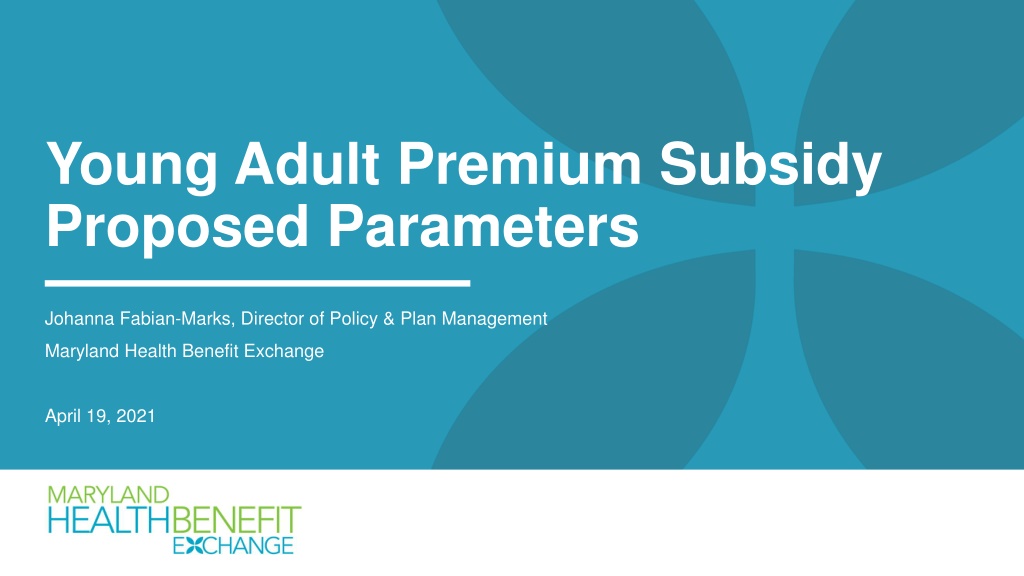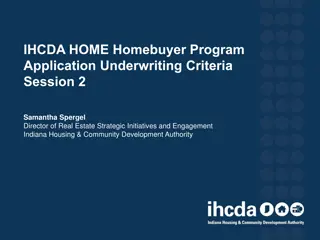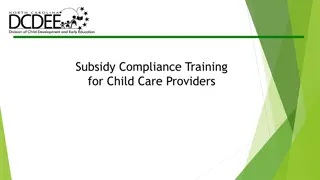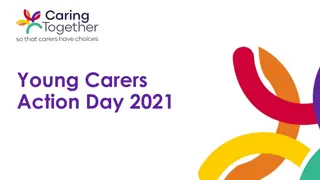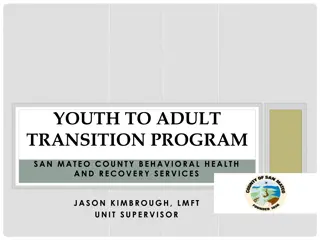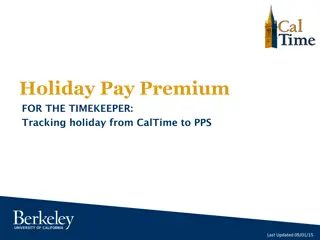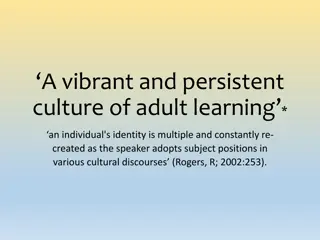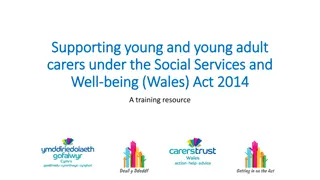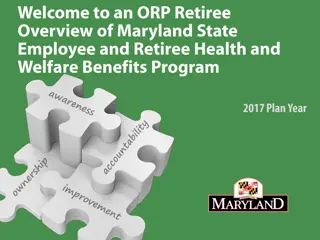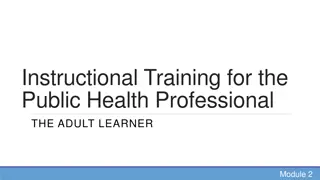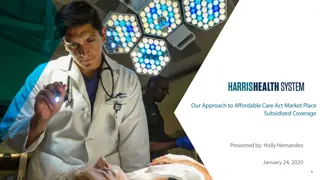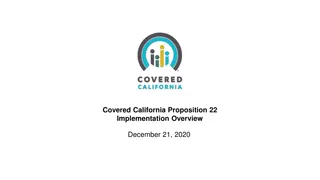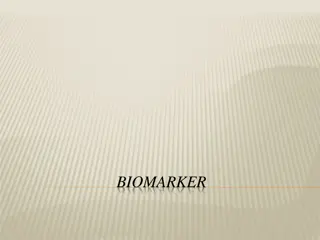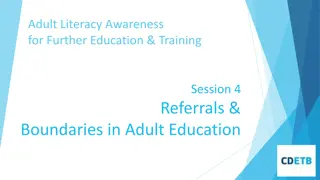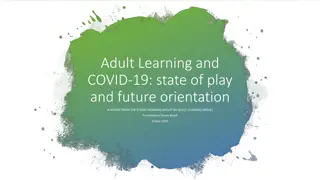Young Adult Premium Subsidy Program Parameters
The Maryland Health Benefit Exchange is proposing a Young Adult Premium Subsidy Program to address the uninsured population aged 18-40 with incomes between 133% and 400% of the Federal Poverty Level. The program aims to provide subsidies for health insurance coverage with specific eligibility and payment parameters. Learn more about the proposed parameters, background legislation, and projected costs for 2022 in this informative material.
Download Presentation

Please find below an Image/Link to download the presentation.
The content on the website is provided AS IS for your information and personal use only. It may not be sold, licensed, or shared on other websites without obtaining consent from the author.If you encounter any issues during the download, it is possible that the publisher has removed the file from their server.
You are allowed to download the files provided on this website for personal or commercial use, subject to the condition that they are used lawfully. All files are the property of their respective owners.
The content on the website is provided AS IS for your information and personal use only. It may not be sold, licensed, or shared on other websites without obtaining consent from the author.
E N D
Presentation Transcript
Young Adult Premium Subsidy Proposed Parameters Johanna Fabian-Marks, Director of Policy & Plan Management Maryland Health Benefit Exchange April 19, 2021
Agenda 1. Background 2. Proposed Program Parameters 3. Next Steps 2
Background HB 780/SB 729 (2021), which establish a young adult subsidy pilot program, passed the legislature. If the Governor takes no action, they will become law on June 1. This legislation grew out of work done throughout 2020. o In accordance with HB 196/SB 124 (2020), MHBE submitted a report to the legislature evaluating a state-based individual market health insurance subsidy on Dec. 1, 2020. To inform the report: o MHBE worked with Lewis & Ellis, in consultation with the MIA, to complete an actuarial analysis, which was published for public comment from Oct. 2-Nov. 2, 2020. o MHBE formed a stakeholder work group that met in fall 2020 and produced a report of recommendations. 3
HB 780/SB 729 Maryland Health Benefit Exchange State-Based Young Adult Health Insurance Subsidies Pilot Program Directs MHBE, in consultation with the Insurance Commissioner and as approved by the Board, to establish eligibility and payment parameters for the pilot program in 2022 and 2023 MHBE shall consider young adults 18-40, between 133% and 400% FPL Directs MHBE to adopt implementing regulations by Jan. 1, 2022 Subject to available funds, in FY 22-24 MHBE may designate reinsurance funds to be used for the program so that not more than $20M in annual subsidies may be provided in CY 22 and 23 4
Uninsured Maryland Adults by Age and Federal Poverty Level Distribution of uninsured Maryland adults with incomes too high for expanded Medicaid coverage, limited to lawfully present residents, by age and income as a percentage of FPL: 2018 Young adults are the largest group of uninsured (67,200; 43% of adult uninsured). A majority are below 400% FPL. Source: Analysis by Families USA National Center for Coverage Innovation of 2018 data from the American Community Survey. IPUMS USA, University of Minnesota, www.ipums.org. Note: ACS data do not include immigration status. These estimates impute immigration status based generally on previous Urban Institute results. 5
Proposed 2022 Young Adult Subsidy Program Parameters Eligibility Age: 18-34 (18 or older; younger than 35) Income: 138% to 400% FPL Eligible to enroll through MHC Enrolled through MHC Enrollment cap if projections indicate that budget may be exceeded Subsidy Design Reduce the maximum expected contribution by 2.5% between ages 18 and 30 For ages 31 to 35, reduce the 2.5% reduction by 0.5% each year Projected 2022 cost: $17M Expected Contribution (EC) for Benchmark Plan Proposed MD Young Adult EC 31 32 -2.0% -1.5% 0.00% 0.00% 0.00% 0.50% 2.00% 2.50% 4.00% 4.50% 6.50% 7.00% Federal EC % FPL 18-30 -2.5% 0.00% 0.00% 1.50% 3.50% 6.00% 33 34 35 -1.0% 0.00% 1.00% 3.00% 5.00% 7.50% -0.5% 0.00% 1.50% 3.50% 5.50% 8.00% -0.0% 0.00% 2.00% 4.00% 6.00% 8.50% 150 200 250 300 400 0.00% 2.00% 4.00% 6.00% 8.50% 6
Proposed MD Young Adult Subsidy Expected Contribution Levels by FPL, Compared to Federal Levels 9% 8% 7% Expected Contribution 6% 5% 4% 3% 2% 1% 0% 18-30 31 32 33 34 35 Age YA200% Fed200% YA250% Fed250% YA300% Fed300% YA400% Fed400% 7
Young Adult Subsidy Example: 28-year-old in Baltimore City Benchmark Premium After APTC + State Subsidy After APTC + State Subsidy Benchmark Plan Monthly Premium Benchmark Plan Monthly Premium Benchmark Premium After APTC After APTC Income FPL Federal EC $31,900 250% 4.00% Income FPL State EC $31,900 250% 1.50% SLCSP cost APTC State Subsidy Net Premium $293 $187 n/a $106 SLCSP cost APTC State Subsidy Net Premium $293 $187 $66 $40 8
Other Subsidy Structures Considered Maximum Applicable Percentage by Subsidy and Age at 200% of the FPL Maximum Applicable Percentage 3% 2% This graph illustrates the impact of each subsidy by age. The graph focuses on an individual at 200% of the FPL these lines will vary at other income levels. For higher incomes (e.g., 300% of FPL), AASE becomes the richest subsidy structure. 1% 0% 18 19 20 21 22 23 24 25 26 27 28 29 30 31 32 33 34 35 Age APTC AASE Proposed Subsidy (AYEA) AASE cliffless to 35 AASE to 30; L.I. to 35 AASE +1%; L.I. to 35 AYEA -3.5% 9
Next Steps April 19: Board votes on proposed 2022 parameters April 19-30: Public comment period May 17: Board votes on final 2022 parameters 10
Motion I move to [approve/defer/reject] the proposed young adult premium subsidy parameters for plan year 2022 [as presented] or [as amended]. 11
Reinsurance Update Our last actuarial analysis in July 2020 estimated federal funding would exceed program cost for all years of the waiver Recent data challenges some assumptions in the July 2020 analysis o Lower federal funding for 2021: CMS estimate for 2021 is 25% below 2020 level Federal funding may increase if recalculated to account for American Rescue Plan Act o Slightly higher cost for 2020: Recent CMS estimates lead us to estimate 2020 costs will be ~7% above projection Legislative draws on reinsurance funding o FY22 budget transfers $100M in state funds from the reinsurance fund in FY 21 and FY 22 o SB 172 would transfer $15M in state funds from the reinsurance fund in each of FY 23-25 13
Actual & Projected SRP Fund Expenses and Income SRP Cost $352,798,597 New: 405,000,000 New: 445,500,000 2019 Act. 2020 Est. Orig: $377,828,828 2021 Est. Orig: $416,782,404 2022 Est. Orig: $447,975,589 New: 490,000,000 2023 Est. Orig: $478,434,269 New: $539,000,000 $100,000,000 $100,000,000 Budget Transfer $20,000,000 $20,000,000 YA Subsidy $15,000,000 Health Equity Orig: $628,614,048 New: $335,000,000 Orig: $684,842,457 New: $358,000,000 Orig: $567,748,703 New: $335,383,207 $373,395,635 $447,277,359 Fed. Funding $118,517,416 $112,591,545 $118,896,671 $125,554,885 $326,889,258 State Funding End of Year Balance Fed. $20,249,819 $0 $0 $0 $62,874,397 End of Year Balance - State $326,889,258 $445,406,674 $410,755,823 $254,602,494 $164,552,379 14
Actual & Projected SRP Fund Expenses and Income - Caveats Numbers presented in previous chart are high-level estimates Federal funding for 2021 may be higher than shown if CMS incorporates the effect of the American Rescue Plan Act Lewis & Ellis will be doing a detailed update of reinsurance projections between now and July 15
Projected Impact of Proposed Subsidy* 2023 Increase in Enrollment 2021 % enrolled of eligible 2023 % enrolled of eligible 2023 Gross Premium PCPY 2023 Net Premium PCPY 2023 State Subsidy PCPY 41% 64% 21,800 $4,587 $713 $537 % Subsidy Recipients who are New Enrollees by 2023 49% 2022 Change in Morbidity Impact to Premiums (all) 2022 YA Subsidy Cost 2023 YA Subsidy Cost 2023 Cost per New Member $17.0M $19.4M -4.6% $888 *Assumes ARPA APTC levels are continued in 2023 16
Other Subsidy Structures Considered - Impacts Advantages of the proposed subsidy compared to other subsidy structures that were modeled Most efficient as measured by cost per new member Increase in enrollment and impact to premiums comparable to more costly structures Design targets aid to lower-income young adults Within budget Simple formula 0 A B C D E F G H I J K % Subsidy Recipients who are New Enrollees by 2023 2023 Gross Premium PCPY 2022 Change in Morbidity Impact to Premiums (all) 2021 % enrolled of eligible 2023 % enrolled of eligible 2023 2023 State 2022 2023 2023 Cost per New Member 2023 Increase in Enrollment Net Premium PCPY YA Subsidy Cost YA Subsidy Cost Scenario Age Subsidy PCPY Reinsurance 18-34 41% 41% - $4,782 $1,035 $0 - - - - - Subsidies for Young Adults under 400% FPL AASE $1,312 18-34 67% 24,400 $4,584 $486 $857 $27.4M $32.0M -5.0% 53% Proposed Subsidy $4,587 $713 $537 $888 18-34 41% 64% 21,800 $17.0M $19.4M -4.6% 49% AASE 34 $4,820 $948 $131 $997 18-34 45% 3,300 $3.1M $3.3M -0.8% 11% Variation of original AASE with no cliff (LI = linear interpolation) AASE 30; LI to 35 $4,598 $594 $732 $1,148 18-34 41% 66% 23,400 $23.1M $26.9M -4.9% 51% AASE; LI to 40 18-39 Not modeled was most expensive YA subsidy in original modelling and would be more expensive than AASE Variation between the original AASE and AYEA (LI = linear interpolation) AASE +1%; LI to 35 $4,714 $887 $532 $1,122 18-34 41% 57% 15,000 $14.5M $16.9M -3.1% 39% AYEA -3.5% $4,582 $561 $719 $1,126 18-34 41% 66% 23,600 $23.2M $26.5M -4.8% 52% 17
Young Adult Subsidy Structures Detailed (1/2) Maximum Applicable Percentage by Subsidy and Age at various FPL 200% FPL 250% FPL Maximum Applicable Percentage Maximum Applicable Percentage 4% 4% 3% 3% 2% 2% 1% 1% 0% 0% 18 19 20 21 22 23 24 25 26 27 28 29 30 31 32 33 34 35 Age 18 19 20 21 22 23 24 25 26 27 28 29 30 31 32 33 34 35 Age APTC AYEA AASE +1%; L.I. to 35 The graphs above illustrate the income cap (maximum applicable percentage) for three scenarios at various FPLs: 1) APTC (federal APTC under ARPA), 2) AYEA, and 3) AASE+1% with linear interpolation to 35. The distance between a Young Adult scenario and the APTC scenario is the state subsidy. AYEA is richer for lower income groups (and results in a free plan for those at or below ~212% FPL), while AASE+1%, LI to 35 is richer for higher income groups. 18
Young Adult Subsidy Structures Detailed (2/2) Maximum Applicable Percentage by Subsidy and Age at various FPL 300% FPL 400% FPL 9% 9% Note: y-axis scale is different between previous slide and current slide Maximum Applicable Percentage Maximum Applicable Percentage 6% 6% 3% 3% 0% 0% 18 19 20 21 22 23 24 25 26 27 28 29 30 31 32 33 34 35 Age 18 19 20 21 22 23 24 25 26 27 28 29 30 31 32 33 34 35 Age The graphs above illustrate the income cap (maximum applicable percentage) for three scenarios at various FPLs: 1) APTC (federal APTC under ARPA), 2) AYEA, and 3) AASE+1% with linear interpolation to 35. The distance between a Young Adult scenario and the APTC scenario is the state subsidy. APTC AYEA AASE +1%; L.I. to 35 AYEA is richer for lower income groups (and results in a free plan for those at or below ~212% FPL), while AASE+1%, LI to 35 is richer for higher income groups. 19
Young Adult Subsidy Structures Formulas AYEA Subsidy formula Reduce the maximum applicable percentage by 2.5% between ages 18 and 30. For ages 30 to 35, reduce the 2.5% reduction by 0.5% for each age (i.e., 2.0% for 31, 1.5% for 32, , 0% for 35 etc.) Examples A 21-year-old at 200% of FPL pays 2% of income on premiums (under ARPA APTC structure). The AYEA would reduce this young adult s percentage to 0% (2% - 2.5% = -0.5%, which is floored at 0%). A 33-year-old at 300% of FPL pays 6% of income on premiums (under ARPA APTC structure). The AYEA would reduce this young adult s percentage to 5% (6% - 2.5% + (0.5% X 3)) = 5%). AASE+1%, LI to 35 Subsidy formula For ages 18 to 30, use the formula: ??? ?????????? ?????????? = ??????? ?????????? ?????????? Between ages 30 to 35, linearly interpolate the applicable percentage from the new applicable percentage for age 30 and the federal applicable percentage (since age 35 does not qualify for a subsidy). Examples A 21-year-old at 200% of FPL pays 2% of income on premiums (under ARPA APTC structure). The AASE+1%, LI to 35 would reduce this young adult s percentage to 1.67% (2% X (11 / 3) + 1% = 1.67%). A 33-year-old at 300% of FPL pays 6% of income on premiums (under ARPA APTC structure). The AASE+1%, LI to 35 would reduce this young adult s percentage to 4.91%. For age 30 at 300% FPL, the applicable percentage would be 3.27% (6% X (1.1351 / 3) + 1% = 3.27%) For age 35 at 300% FPL, the applicable percentage would be 6% (does not qualify for a subsidy). Linearly interpolating between the two, results in 4.91% for age 33. ???????? ? ???. ??? ????1 3 + 1% 1 The Enrollee s Avg. Age Rate is based on a 3:1 ACA age curve. This age curve has a 1.0 factor for age 21 and 3.0 factor for age 64. In the example listed, age 30 s age curve factor is 1.135. 20
The Reinsurance Program Has Successfully Reduced Premiums Monthly premiums are down an average of 11.9% for 2021, and more than 30% compared to 2018 In 2021, Maryland s lowest cost plans will be about 20-30% below US averages, depending on metal level Individual Premium Change 2014 n/a 2015 10% 2016 18% 2017 21% 2018 50%* 2019 -13% 2020 -10% 2021 -12% Data from Kaiser Family Foundation, Average Marketplace Premiums by Metal Tier, 2018-2020 , available at https://www.kff.org/health- reform/state-indicator/average-marketplace-premiums-by-metal-tier Plan Year *This reflects increases to on-exchange silver plan premiums to adjust for the fact that the federal government stopped making cost-sharing reduction payments. Absent this adjustment, the average premium change would have been 28%. The additional increase is largely born by higher APTCs from the federal government rather than paid directly by consumers. 21
But Not Everyone Feels the Benefit of the Reinsurance Program Comparison of 2021 Benchmark Plan Monthly Out-of-Pocket Premium Cost for 27-Year-Old in Baltimore City at 250% and 400.5% FPL, With and Without the Reinsurance Program The benefits of the reinsurance program are primarily felt by households earning >300% FPL and particularly households earning >400% FPL (about $51,000 for an individual or $105,000 for a family of four), who earn too much to qualify for federal premium subsidies Because of the way the federal subsidy structure works, reductions in premiums resulting from the reinsurance program are not typically felt by individuals at lower FPLs. As a result, the reinsurance program is not an effective way to reduce premiums for individuals at lower FPLs, or to target subsidies towards specific populations such as young adults. 22
